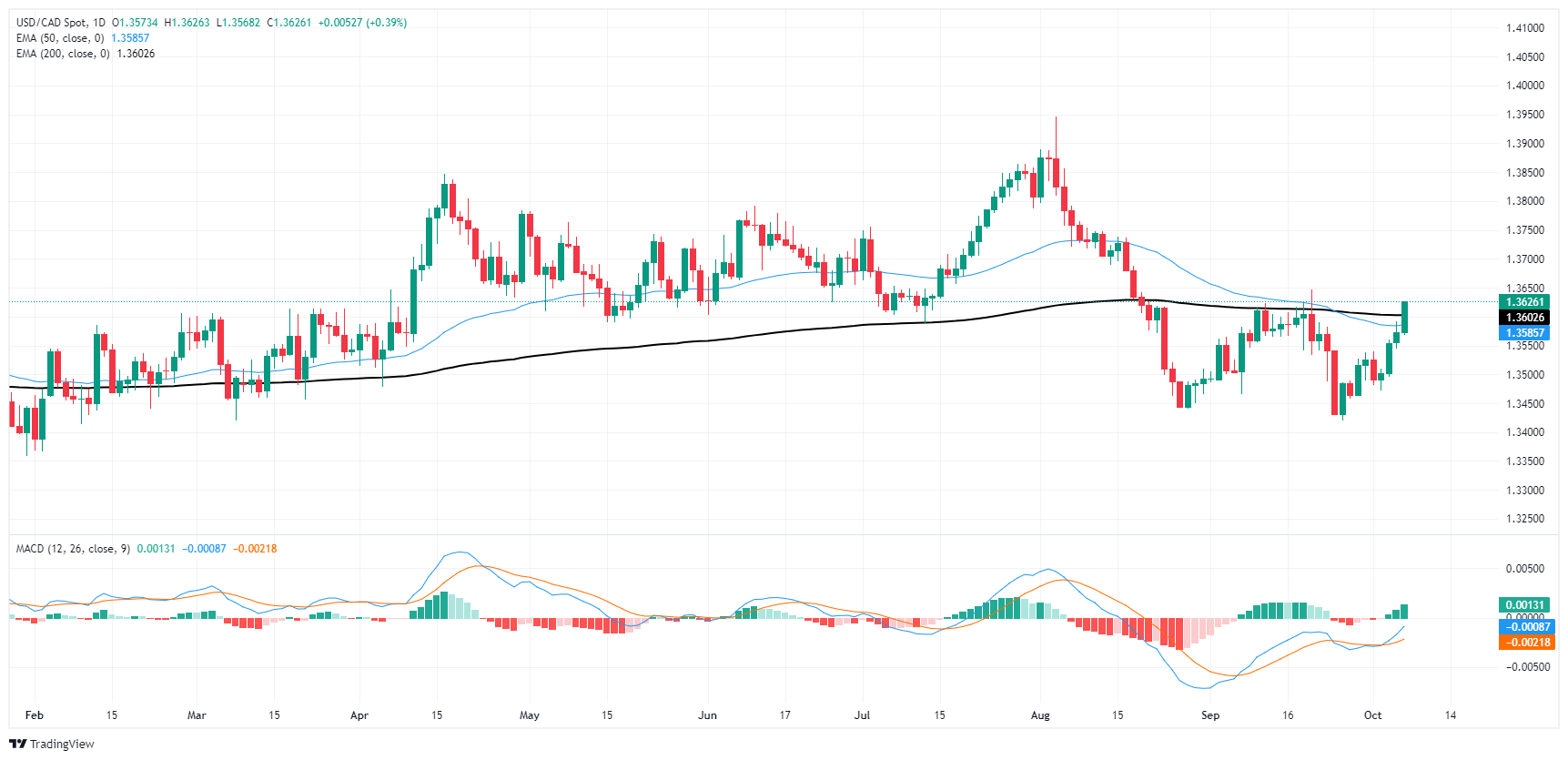- he Canadian Dollar continues to lose ground to the Greenback.
- Markets have tilted into a broadly risk-off stance to kick off the new week.
- Canada remains largely absent from the economic calendar until Friday.
The Canadian Dollar (CAD) backslid into long-term averages against the US Dollar on Monday, with markets opening up the new trading week notably on the back foot. Investors pulled back into the safety of the Greenback, sending the Canadian Dollar skidding into three-week lows.
Meaningful economic data from Canada remains entirely absent from the economic data docket this week, at least until fresh prints in Canadian labor data, due on Friday. Canadian Trade Balance figures are due on Tuesday but are almost guaranteed to have little to no market impact.
Daily digest market movers
- Rising risk-off sentiment pummels the CAD on Monday.
- Markets are facing a lower forecast for the pace of rate cuts than many expected earlier in the year.
- Odds of further outsized rate cuts from the Fed are evaporating as the US labor market remains stubbornly healthy.
- Fed remains tepid on further rate cuts, bets of no rate change in November are on the rise.
- Fed's Kashkari: Balance of risks has tilted toward higher unemployment
Canadian Dollar price forecast
USD/CAD is currently trading at 1.36245, having recently bounced from the 1.3500 level. Notably, price action has moved above the 200-day Exponential Moving Average (EMA), a critical level that often signals a shift in trend direction when breached. The break above this longer-term EMA suggests that bullish momentum may be gaining traction, and this level could act as a new support zone.
Additionally, the 50-day EMA is slightly below the current price, further reinforcing the bullish outlook. The crossing above both the 50-day and 200-day EMAs in quick succession strengthens the case for a potential rally in the coming days, assuming no significant pullback occurs.
The MACD histogram also indicates a bullish shift, as the MACD line (blue) has crossed above the signal line (orange), suggesting an increase in upward momentum. This crossover, along with a steadily rising histogram, points to a potential continuation of the upward movement.
However, it’s important to note that the pair is approaching resistance near the 1.3650 level, which has previously acted as a strong psychological and technical barrier. If USD/CAD manages to break and sustain above this level, it could open the door for further gains, with the next key resistance zone around 1.3800.
USD/CAD daily chart
Fed FAQs
Monetary policy in the US is shaped by the Federal Reserve (Fed). The Fed has two mandates: to achieve price stability and foster full employment. Its primary tool to achieve these goals is by adjusting interest rates. When prices are rising too quickly and inflation is above the Fed’s 2% target, it raises interest rates, increasing borrowing costs throughout the economy. This results in a stronger US Dollar (USD) as it makes the US a more attractive place for international investors to park their money. When inflation falls below 2% or the Unemployment Rate is too high, the Fed may lower interest rates to encourage borrowing, which weighs on the Greenback.
The Federal Reserve (Fed) holds eight policy meetings a year, where the Federal Open Market Committee (FOMC) assesses economic conditions and makes monetary policy decisions. The FOMC is attended by twelve Fed officials – the seven members of the Board of Governors, the president of the Federal Reserve Bank of New York, and four of the remaining eleven regional Reserve Bank presidents, who serve one-year terms on a rotating basis.
In extreme situations, the Federal Reserve may resort to a policy named Quantitative Easing (QE). QE is the process by which the Fed substantially increases the flow of credit in a stuck financial system. It is a non-standard policy measure used during crises or when inflation is extremely low. It was the Fed’s weapon of choice during the Great Financial Crisis in 2008. It involves the Fed printing more Dollars and using them to buy high grade bonds from financial institutions. QE usually weakens the US Dollar.
Quantitative tightening (QT) is the reverse process of QE, whereby the Federal Reserve stops buying bonds from financial institutions and does not reinvest the principal from the bonds it holds maturing, to purchase new bonds. It is usually positive for the value of the US Dollar.
Information on these pages contains forward-looking statements that involve risks and uncertainties. Markets and instruments profiled on this page are for informational purposes only and should not in any way come across as a recommendation to buy or sell in these assets. You should do your own thorough research before making any investment decisions. FXStreet does not in any way guarantee that this information is free from mistakes, errors, or material misstatements. It also does not guarantee that this information is of a timely nature. Investing in Open Markets involves a great deal of risk, including the loss of all or a portion of your investment, as well as emotional distress. All risks, losses and costs associated with investing, including total loss of principal, are your responsibility. The views and opinions expressed in this article are those of the authors and do not necessarily reflect the official policy or position of FXStreet nor its advertisers. The author will not be held responsible for information that is found at the end of links posted on this page.
If not otherwise explicitly mentioned in the body of the article, at the time of writing, the author has no position in any stock mentioned in this article and no business relationship with any company mentioned. The author has not received compensation for writing this article, other than from FXStreet.
FXStreet and the author do not provide personalized recommendations. The author makes no representations as to the accuracy, completeness, or suitability of this information. FXStreet and the author will not be liable for any errors, omissions or any losses, injuries or damages arising from this information and its display or use. Errors and omissions excepted.
The author and FXStreet are not registered investment advisors and nothing in this article is intended to be investment advice.
Recommended content
Editors’ Picks

AUD/USD stays firm near 0.6300 amid modest risk appetite
AUD/USD is posting small gains near 0.6300 in early Asian trades on Monday, opening the week on the front foot. Risk sentiment remains in a sweeter spot following the weekend's news of lower US tariffs on Chinese electronic supply chain. Tariffs talks will remain on the radar.

USD/JPY rises above 143.50 at the weekly opening
USD/JPY is trading well bid above 143.50 amid a positive start to the Holy Friday week. The US Dollar holds the rebound from multi-year troughs, digesting Trump's tariff news from the weekend. The Fed-BoJ policy divergence expectations will keep the Japanese Yen supported, limiting the pair's upside.

Gold retreats from record highs of $3,245 as US Dollar finds its feet
Gold is rereating from record highs of $3,245 early Monday, extending Friday's late pullback. Reducded demand for safe-havens and a broad US Dollar rebound undermine the yellow metal amid the news of not-so-steep US tariffs on China's semiconductors and electronics.

Week ahead: ECB set to cut, BoC might pause as Trump U-turns on tariffs
ECB is expected to trim rates, but the BoC might pause this time. CPI data also in the spotlight; due in UK, Canada, New Zealand and Japan. Retail sales the main release in the United States. China GDP eyed as Beijing not spared by Trump.

Is a recession looming?
Wall Street skyrockets after Trump announces tariff delay. But gains remain limited as Trade War with China continues. Recession odds have eased, but investors remain fearful. The worst may not be over, deeper market wounds still possible.

The Best brokers to trade EUR/USD
SPONSORED Discover the top brokers for trading EUR/USD in 2025. Our list features brokers with competitive spreads, fast execution, and powerful platforms. Whether you're a beginner or an expert, find the right partner to navigate the dynamic Forex market.



